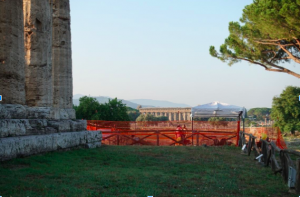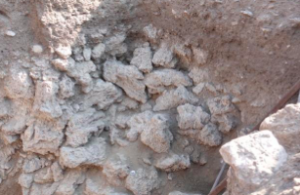An Archaeological Summer in Southern Italy
By Julian Danetiu, Class of 2019
 Finding summer opportunities as an undergraduate can be one of the most intimidating yet rewarding endeavors undertaken in a college career. It was only while searching for on-campus jobs this past winter that I was offered the chance to interview for a role in the excavation of the Temple of Athena in Paestum, Italy. After weeks of dead-end online applications and phone calls I was fortunate enough to stumble upon an opportunity which would offer unmatched academic and leadership development (as well as some intense physical exercise) at one of the most pristine UNESCO World Heritage sites available! Eager to introduce myself I promptly responded to the invitation and arranged an appointment to meet with the professor in charge to review the responsibilities, duties, and expectations I needed to uphold throughout the project.
Finding summer opportunities as an undergraduate can be one of the most intimidating yet rewarding endeavors undertaken in a college career. It was only while searching for on-campus jobs this past winter that I was offered the chance to interview for a role in the excavation of the Temple of Athena in Paestum, Italy. After weeks of dead-end online applications and phone calls I was fortunate enough to stumble upon an opportunity which would offer unmatched academic and leadership development (as well as some intense physical exercise) at one of the most pristine UNESCO World Heritage sites available! Eager to introduce myself I promptly responded to the invitation and arranged an appointment to meet with the professor in charge to review the responsibilities, duties, and expectations I needed to uphold throughout the project.
This year’s portion of the North Urban Paestum Project primarily sought to investigate the geomorphology of the foundation of the Temple of Athena, which itself lies on an elevated position relative to the rest of the archaeological park; the park also hosts two other temples (Temple of Hera and Temple of Neptune) as well as the ruins of the ancient city. My role in the project would be to lead the documentation and organization of media collected throughout the project’s duration so that our data could be better preserved as well as accessed by others studying the project’s findings in the future. Academically speaking, as an environmental biology major my main interest was in constructing an understanding of the ancient peoples’ relationship with their coastal environment, including how it affected city planning, productivity, and even diets. 
The excavation plots, or “trenches”, of 3 x 2 meters were divided into 6 meter-square sections with finds being catalogued by which square as well as which stratigraphic unit they were recovered from in order to designate depth within each trench. Through this we were able to record a location in 3-dimensional space for finds within each trench, giving us an idea of the time period each object hailed from. Our first trench dealt more with recovering cultural artifacts such as pottery or faunal remains, while the second trench aimed directly at uncovering more about the Temple of Athena’s geomorphology.
Paestum has seen a number of different occupants over the past two millennia, some evidence of which we were able to recover in the form of refuse, ceramics, and sacrificial remains. The most recent visitors, Allied invaders during World War II, landed on the beaches of Paestum and slowly captured ground, pushing Axis forces north-eastwards towards nearby mountain ranges. As part of the Allied invasion several base camps had to be set up as land was taken, including communications and field hospital stations; these were installed next to and even within the temples themselves! From this occupation we were able to recover some minor artifacts such as discarded tin-cans and empty ammunition shells.
 Digging deeper we came across an abundance of pottery shards, some with glazes or painted designs giving hints to their original time period and even purpose. Paestum’s earliest settlers, including the Greek colonists, the later Lucanians, and eventual Roman imperialists relied heavily on ceramic containers for storing food or fermenting beverages. We worked closely with the Museum of Paestum, a component of the Parco Archeologico di Paestum itself, which specialized in reconstructing artifacts from recovered fragments. The Museo also had on display a terrific number of finds from past years of excavation, including weapons, tools, sculpted metopes, and even entire intact sections of tomb walls!
Digging deeper we came across an abundance of pottery shards, some with glazes or painted designs giving hints to their original time period and even purpose. Paestum’s earliest settlers, including the Greek colonists, the later Lucanians, and eventual Roman imperialists relied heavily on ceramic containers for storing food or fermenting beverages. We worked closely with the Museum of Paestum, a component of the Parco Archeologico di Paestum itself, which specialized in reconstructing artifacts from recovered fragments. The Museo also had on display a terrific number of finds from past years of excavation, including weapons, tools, sculpted metopes, and even entire intact sections of tomb walls!
In terms of the project’s primary goal, we were ultimately successful in collecting data supporting our directors’ hypotheses that the “artificial mound” underlying the Temple was in fact composed almost entirely of travertine masses. Travertine, a calcareous rock resulting from the gradual deposition of minerals dissolved in local bodies of water, is especially light in weight and brittle due to its nature of formation. We believe that because of these properties ancient architects found it to be the perfect candidate as a “filler” for the artificial mound as it was easy to transport and readily available throughout the surrounding environments. Excavation of trench 2 thus focused on the location of travertine masses used to build the artificial mound, the sizes of these masses, and their orientations when discovered. Ancient planners had most likely ordered masses to be “dumped” into the fill before covered with earth, thus allowing the Temple of Athena to stand on an elevated mound relative to the surrounding city. 
Although some of us were assigned with special tasks, such as media documentation or cataloguing, we each had the privilege of taking part in day labor, all the while learning various archaeological techniques in a very real hands-on environment. Hours were long and arduous, waking to roosters at the crack of dawn and watching the sun climb from one end of the sky to the other as we excavated and sifted through meters of earth every day for six weeks, excluding most — but not all — weekends. After returning to our homestay we’d walk across the road to the local beach and have a chance to enjoy the waters of the Gulf of Salerno before returning for dinner. We worked and lived with students from the Universities of Venice and Bologna, who themselves were as cordial and hardworking as we could ever ask for, learning a great deal about their regions’ local cultures while they heard of ours (we earned the honorable title of “American Barbarians” after exchanging some details, mainly about food preparation). As a member of the dig who had been working with the professors at Colgate since April and was the last to depart from Paestum in mid-August, I could not have imagined a more rewarding way of spending my summer break. Thanks to the generosity of the Benton Scholar program, as well as Colgate University as a whole, many of us were able to take part in a once-in-a-lifetime experience doing something that mattered greatly to the established realm of classical archaeology.

